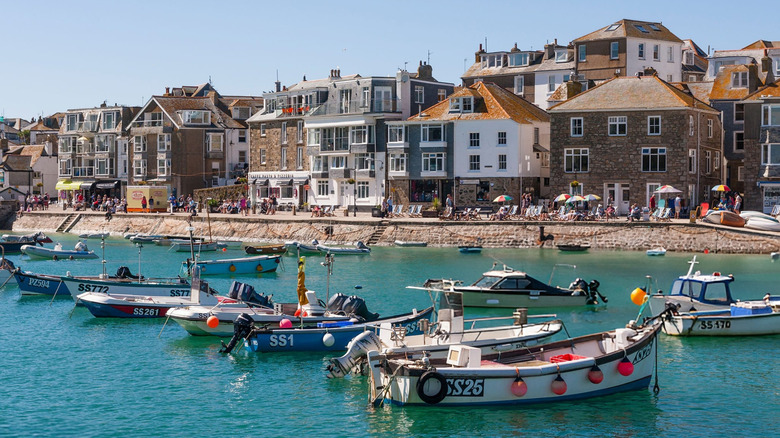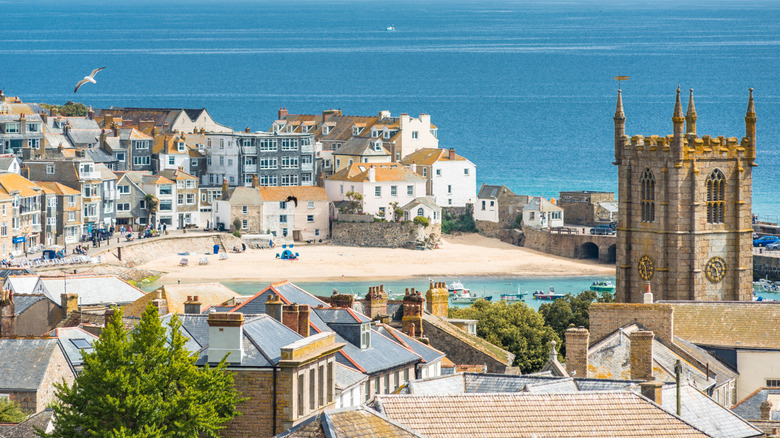One Of England's Most Idyllic Fishing Towns Is A Coastal Cornwall Paradise With Charming Cobbled Streets
When it comes to iconic British seaside destinations, a place like the Jurassic Coast might spring to mind, a beautiful coastline that belongs on any history and fossil-lover's bucket list. Or you might embark on the "ultimate road trip" along Scotland's scenic coastline, where you can spot seabirds on the North Sea and stroll along the shores of picturesque saltwater lochs. Journey to the southwestern edge of England and you'll find yourself in Cornwall. Seaside destinations like Land's End feature hidden beachy coves and dramatic cliffs, and oceanside towns like Tintagel perch on the Atlantic Coast, boasting historic ruins and delicious Cornish pasties. And you definitely won't want to miss St. Ives.
St. Ives sits on the northern edge of Land's End, a finger-like projection that juts out into the Celtic Sea at Cornwall's westernmost tip. Until the late 19th century, the town was predominantly a hub for tin extraction and fishing, and the community's main industry was fishing for pilchard, or sardines. Amid no shortage of quaint cobbled streets, artistic heritage, fantastic accommodation options, and shining beaches, the region's seafood remains one of this area's top attractions.
St. Ives Bay features pristine white sand beaches and Caribbean-blue waters, a hit when it comes to sunbathing, swimming, and paddleboarding. If you can't resist taking to the water, join a workshop with St. Ives Surf School for surfing off of Porthmeor Beach or "coasteering," which will have you swimming into coves and jumping off coastal outcrops. To make things even sweeter, Porthmeor Beach has also been awarded a Blue Flag, recognizing its cleanliness and sustainability. Or, set out for deeper waters with a chartered scenic boat ride or fishing trip with Bluefin Charters.
Take in seaside sights and art in St. Ives
Part of what makes St. Ives so charming is its narrow cobblestone streets, with quaint cottages and historic buildings packed in like — as they say — sardines! Many of these older structures can be easily accessed as you walk around town, like the Venton Ia Well, which takes its name from the Cornish word for "well" and St. Ia, the patron saint of St. Ives. If you're here in February for the patron saint's feast day celebration, this wishing well is a focal point of a blessing that kicks off the day's festivities. You'll also love St. Leonard's Chapel, a small stone fishermen's chapel dating back to at least 1577. There's another similar chapel out on St. Ives Head called St. Nicholas Chapel, which goes back even further to at least the mid-1400s.
For more than 100 years, St. Ives has also distinguished itself as a mecca for artists. In fact, there's a whole movement called the St. Ives School that developed organically in the mid-20th century when creatives like Barbara Hepworth, Ben Nicholson, and Christopher Wood congregated there. The area had attracted artists for decades thanks to its glorious light, and continues to do so. Today, you can delve into Hepworth's creativity in her home and studio at the Barbara Hepworth Museum and Sculpture Garden.
The art opportunities certainly don't end there. Tate St. Ives brings international contemporary art to its location overlooking Porthmeor Beach, and a nonprofit-fueled artist studio program called Porthmeor Studios provides artists with space to work. The organization regularly holds artist talks and open studio events.
Settle in for great seafood and cozy accommodations
You're in luck when it comes to culinary delights in St. Ives. You can't go wrong with a nip to the local chippy, like one literally called Local Fish and Chips. Alternatively, check out fan favorites like The Razor Clam, Porthminster Kitchen, The Mermaid Seafood Restaurant, Walter's on the Beach, and more. Reservations are often encouraged, and many restaurants open up their calendars months in advance, so if there's a place you know you simply cannot miss, book ahead.
The drive to St. Ives is over five hours from London, and there are also regular trains from London Paddington that take five to six hours, with often only one change. If you have a car, pay close attention to parking options, too, because they can be hard to find during the busier months. One popular option is the Park and Ride train, also called the St. Ives Bay Line, which takes only 10 minutes as it glides along the scenic coastline.
Since the brass tacks are often the most important, book accommodation early. St. Ives is immensely popular with visitors from all over the world, so small guest houses might book up during peak season. Highly rated hostels like Cohort and Lower Pendeleath St. Ives Farm offer budget-friendly options, or you can check into one of the city's many well-appointed hotels. Harbor View House St. Ives Hotel offers unparalleled views, or if you're looking for something just a little artsier, drop your bags at the playfully named Storm in a Teacup, a guest house with fun features like mirrors repurposed from a decommissioned Penzance steamship.


